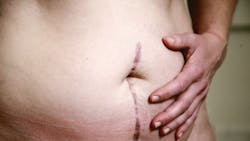Drug enables skin tissue healing without scarring
Stanford Medicine surgeon Michael Longaker, MD and his colleagues have discovered that interfering with certain molecular signals during healing can produce tissue indistinguishable from normal skin, reported the school.
A paper describing their research is in Science. Stanford MD-PhD student Shamik Mascharak is the lead author. Longaker, the Deane P. and Louise Mitchell Professor in the School of Medicine, and Geoffrey Gurtner, MD, the Johnson & Johnson Distinguished Professor in Surgery II, are the senior authors.
Nearly everyone has some sort of scar. Longaker estimates that every year in the United States, nearly 50 to 80 million new scars are produced by surgery, and many more result from accidents. Scarring is not merely a cosmetic issue: Scar tissue has no hair follicles and no sweat glands and is inflexible and weaker than skin. Scars can limit our bodies’ ability to move and adapt to changing temperatures.
“There is currently no drug or molecular strategy for preventing or reversing the fibrotic process of scar formation,” said Longaker, who is also the co-director of the Institute for Stem Cell Biology and Regenerative Medicine.
Scars form, because they seal an opening in the skin more quickly than normal skin could grow, Longaker said. “If you heal slowly you might get an infection or bleed to death. A scar is a spot weld — it covers the wound quickly, but it compromises form and function.” Depending on where a scar forms, he said, people might not be able to bend their elbows, close their eyes or open their mouths much. But in premodern existence, these people were more likely to live, even with such disabilities.
Both Gurtner and Longaker observed that tension during skin repair played a critical role in scarring. Longaker saw how tension made a difference in surgical wounds.
“Early in fetal development, when skin injury doesn’t result in scarring, the skin of the fetus is gelatinous and doesn’t really have the ‘tightness’ we associate with skin,” he said. “At the other end of our lives, if a 95-year-old has been exposed to a lot of sun and has loose skin, scar formation is minimal because he or she doesn’t have that tension in the skin.” Longaker and Gurtner showed that if you lower the forces that pull at the edges of a healing incision, scar formation can be reduced.
But why does tension in the skin during healing result in scar formation? Longaker and Gurtner focused on a gene called engrailed. This gene helps create a protein sometimes found in fibroblasts, a type of skin cell that drives scarring. In a series of experiments, they discovered that a subpopulation of fibroblast cells in the skin that normally don’t express engrailed start to do so during scarring. Next, they looked at the role mechanical stress might play in turning on the engrailed gene. Cells can sense mechanical stress through well-defined mechanisms, yet there are ways to block their ability to do so.
The researchers took fibroblast cells that did not express engrailed and grew them in the laboratory in three different environments: inside a soft gel that did not produce mechanical strain in the growing fibroblasts, on a stiff plastic dish that produced mechanical strain, and on the same strain-inducing plastic but in the presence of a chemical that blocked mechanical-strain signaling. They found that fibroblasts grown on the tension-free gel did not start expressing engrailed, but that the fibroblasts growing on the stress-inducing plastic did. If they added a chemical that blocked mechanical strain signaling, cells grown on plastic did not express engrailed.
When tension was applied to healing surgical incisions, there was an increase in the number of cells expressing engrailed and a thicker scar resulted.
Mascharak, the lead author, identified a drug, verteporfin, which is approved by the U.S. Food and Drug Administration to treat an eye disease by blocking the mechanical-stress signaling in cells. With vertepofin use, the healed skin looked completely normal.
“There must be three things for wound healing to be true skin regeneration,” Longaker said. “The skin needs to have normal hair follicles and glands, it needs to have a normal appearance under a microscope, and it needs to be just as strong as normal skin.”
Mascharak developed an artificial intelligence algorithm that compared microscopic images of skin to see if there were subtle differences that the human eye could not pick up. The algorithm was unable to find any differences between normal skin and skin regenerated with the assistance of verteporfin, Longaker said.
